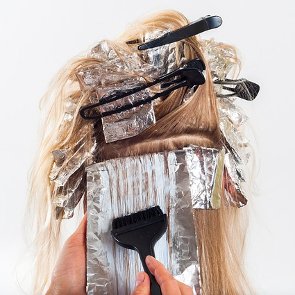4 Ingredients to Avoid in Hair Dyes
 Since their invention in the early 20th century, synthetic hair dyes have become very popular because they allow to achieve a deep, vibrant, and long-lasting hair color. Unfortunately, some of the chemicals used in synthetic hair dyes can be bad for your hair structure and overall health. Here are 4 ingredients that you should avoid in your hair dyes.
Since their invention in the early 20th century, synthetic hair dyes have become very popular because they allow to achieve a deep, vibrant, and long-lasting hair color. Unfortunately, some of the chemicals used in synthetic hair dyes can be bad for your hair structure and overall health. Here are 4 ingredients that you should avoid in your hair dyes.Para-phenylenediamine (p-Phenylenediamine, PPD). The development of synthetic hair dyes became possible thanks to the discovery of the reactivity of PPD with air. More than 150 years later, PPD still remains a common hair dye ingredient despite its drawbacks. PPD is listed as a contact allergen by the Center for Disease Control and Prevention; in 2005–09, it was the tenth most prevalent allergen in patch tests in North America.
PPD may cause contact dermatitis even in individuals who are generally not prone to allergies. And even if there was no reaction the first time you used a hair dye with PPD, there is no guarantee that contact dermatitis won’t develop at some point later because the more you’re exposed to PPD, the more sensitive you’re likely to become. Luckily, there are plenty of PPD-free hair dyes, both plant-based and synthetic.
Ammonia. Ammonia is a compound of nitrogen and hydrogen that is used in many spheres and products, from the synthesis of pharmaceutical products to commercial cleaning products and hair dyes. Although wide in use, ammonia is hazardous in its concentrated form.
Ammonia is used in permanent hair dyes to create the alkaline environment in order to open the cuticle layer of the hair, helping the developer and colorants to penetrate into the hair cortex. Unfortunately, it significantly raises the pH of the hair in the process, which causes the hair to lose keratin (the protein it is made of) and moisture, becoming dry and dull. Besides, ammonia has a strong and unpleasant smell, and it can cause respiratory problems when inhaled.
Resorcinol. Another common ingredient in permanent hair dyes, resorcinol is used in medicine as a disinfectant and antiseptic, as well as in the synthesis of pharmaceutical products. In hair colors, resorcinol interreacts with other chemicals to produce a permanent coloring effect. Like PPD, it is a skin irritant. In addition, it has commonly been linked with endocrine disruption.
Hydrogen peroxide. This is another common chemical compound that can be found in synthetic dyes. It is used as an oxidizing agent (developer) that removes natural pigment from your hair and enables the dye to permanently change hair color. Unfortunately, it also damages hair strands, making them dry and brittle. The problem is, all permanent hair dyes must be mixed with a developer. If you want to protect your hair from the harmful effects of hydrogen peroxide, you should try demi-permanent or semi-permanent hair colors that have a lower concentration of hydrogen peroxide. Plant-based hair dyes like henna and indigo are also an option.
Other known irritants and toxins that can be found in chemical hair dyes include ethanolamine and its derivatives, SLS (sodium lauryl sulfate), parabens, lead acetate, toluene-2,5-diamine (TD), toluene-2,5-diamine sulfate (TDS), and formaldehyde.
To prevent possible allergic reactions, you should do a patch test every time you dye your hair. Apply a small amount of the coloring solution to an inconspicuous area of the skin (for example, behind your ear) and wait for 48 hours to make sure there is no itching, skin redness or other signs of irritation. And keep in mind that you should be especially careful during pregnancy. Even if you’re not allergic to any hair dye ingredients, chemicals can absorb through your scalp and harm your baby.
Breadcrumbs
Filters
- Hair
Tags
Related Articles
- 5 DIY Coconut Oil Hair Masks and Treatments, How to Keep Your Hair Color from Fading in the Summer, 6 Tips for Maintaining Vibrant Hair Color, 7 Ingredients to Avoid in Feminine Intimate Washes